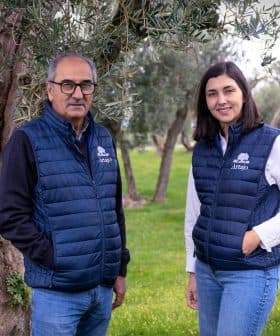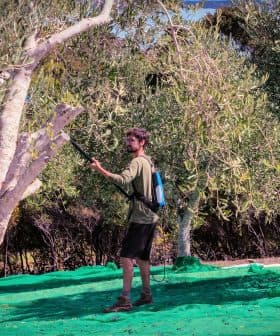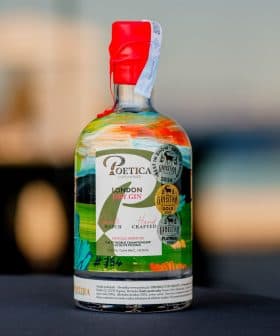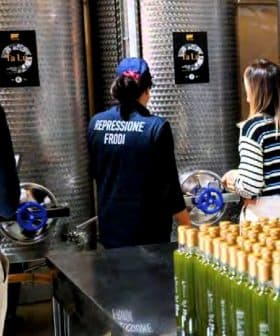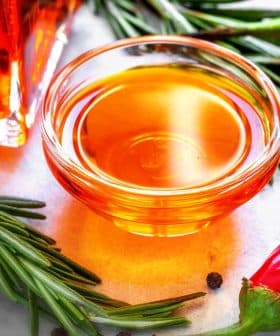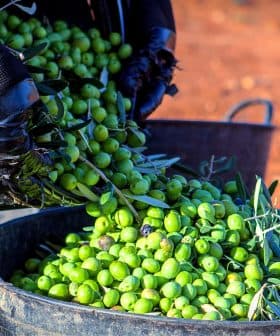Italy’s Severe Drought Damages Olive Trees Ahead of Harvest
The country's major olive-growing regions are hit by heatwaves and drought. Production is anticipated to fall to historic lows.
 Fanaco Lake shows an extremely low level after a winter with scarce precipitation in Castronovo di Sicilia, Italy.. (AP Photo/Andrew Medichini)
Fanaco Lake shows an extremely low level after a winter with scarce precipitation in Castronovo di Sicilia, Italy.. (AP Photo/Andrew Medichini)  8.3K reads
8.3K readsItaly is currently facing a severe drought and heatwave that is significantly impacting olive groves, particularly in the southern regions responsible for most olive oil production. The harsh weather conditions have led to a decline of more than 50 percent in olive oil production in Puglia, with water scarcity and high costs of emergency irrigation exacerbating the situation. The extreme weather conditions have also affected olive production in central and northern regions, with the overall Italian olive oil production expected to decrease by at least 23 percent compared to the previous season.
A relentless drought coupled with extended heatwaves is severely impacting Italy’s olive groves a couple of months before the early harvest.
The southern regions, responsible for most Italian olive oil production, bear the brunt of these harsh weather conditions.
Coldiretti Puglia, a prominent farmers’ association, has warned that the region’s olive oil production may decline by more than 50 percent.
We have already lost the entire olive production for the current season. Moreover, if these weather conditions persist, next season’s production could also be at risk.
Numerous rainfed olive trees in Puglia exhibit signs of water stress, with many olives desiccating on the branches.
In regions where irrigation is possible, water remains scarce. Puglia’s water reservoirs have decreased by 57 percent compared to the previous season, leading to significant losses across the agricultural sector.
“Severe and prolonged drought is compelling farmers to undertake emergency irrigation at exorbitant costs, driven by the high fuel prices needed to extract water from wells and transport it via tankers,” Coldiretti warned. “Artesian wells are collapsing, while shallower wells are vanishing, drying up.”
See Also:Italian Producers Reveal Their Winning Strategies at World CompetitionTemperatures have been consistently soaring above seasonal averages, prompting the Italian Military Aviation Weather Forecast Services to repeatedly warn about extraordinary heatwaves.
The behavior of the protected starling species has shifted due to the heat, exacerbating the challenges faced by olive growers.
Large flocks of these birds are now a persistent presence in the countryside, causing significant damage to local agriculture. Coldiretti noted that each bird can consume up to 20 grams of olives daily.
To alleviate the pressure in olive-growing areas already heavily impacted by the weather, the regional council has temporarily lifted bird protection measures, permitting starling hunting during the peak olive harvest period when the damage is most severe.
Oprol, the association of olive producers in Basilicata, cautioned that the critical condition of olive groves observed since last year has escalated into a more intense emergency phase.
“We have already lost the entire olive production for the current season,” said Paolo Colonna, the association’s president. “Moreover, if these weather conditions persist, next season’s production could also be at risk.”
The situation in Sicily is equally dire. The sparse, light rainfall in some areas over the past two weeks has not relieved the parched soil. The dry weather is causing olive trees in several parts of the island to prematurely drop their olives, a natural response to extreme stress.
The entire region’s agriculture is in a state of emergency, with water reserves plummeting to historic lows.
Where feasible, the local government strives to provide some relief to farms while ensuring adequate water availability for the population. The Italian navy has delivered water supplies to the island.
At the same time, wildfires are rampant, posing new risks to forest areas and the population and complicating drought relief efforts.
Coldiretti reported that fires have already ravaged 5,800 hectares of Sicilian land. Olive, fruit and wine production is expected to collapse, with damages to local farmers potentially reaching €3 billion.
Slightly less severe drought and temperature conditions have also affected central regions, including Lazio and Umbria, home to many significant Italian olive oil companies.
In Umbria, spring rainfall and good flowering had initially raised hopes for a successful season despite this year being an ‘off-year’ in the olive trees’ natural alternate bearing cycle.
However, strong winds, extremely high temperatures and dry weather are challenging local olive farmers. In Trevi, one of Umbria’s historic olive-producing areas, many olives show signs of dehydration.
“The current drought is alarming all olive producers in the region,” Paolo Morbidoni, president of the Umbrian Olive Oil Roads, told RAI news service. “At this moment, all growers need to be cautious and act to mitigate the impacts of the drought as much as possible.”
“The situation in our area remains manageable, though the heat is severely testing the resilience of the olive trees,” Luca Perotti, managing director at the award-winning Tuscan producer Pometti, told Olive Oil Times.
“The plants can endure high temperatures and lack of rain, but the fruits are suffering. Despite being abundant this season, they are turning black,” he said. “This is primarily due to consistently high temperatures exceeding 33 ºC to 35 ºC.”
Pometti said he is mitigating the impacts of the drought by using kaolin clay on his olives to shield them from direct sunlight and the olive fruit fly.
“Typically, this product is used to protect against the olive fruit fly, but we have discovered it also shields the fruits from ‘sunburn,’” he said. “At present, we can’t complain about the field conditions. The grassing and mulching from cutting the grass certainly helps retain good soil moisture. The foliage is dense, and satellite images confirm the positive impact of our efforts.”
Conditions vary significantly in some central and northern regions, where different weather patterns, milder temperatures and excessive rainfall have, in some cases, caused substantial damage.
“Italy is a country [at the moment] meteorologically divided in two and an ongoing climate crisis that is severely challenging agricultural businesses,” said Cristiano Fini, the national president of CIA-Agricoltori Italiani, a farmers’ association.
In Veneto, where excessive rainfall has posed challenges for many farms, the current olive season demands a skilled approach to tree management.
“This year, we likely experienced more rainfall in northern Italy than ever before during the first six months. Consequently, the harvest is progressing very well,” Johannes Pan, marketing manager at the award-winning Paneolio, told Olive Oil Times.
“The positive feedback from competition results demonstrates that our agricultural and production approaches are effective, even in varying conditions,” he said. “Over the past five years, we’ve faced everything from severe drought to excessive rainfall.”
Italia Olivicola, the olive growers’ association, predicted that the ‘off-year’ combined with extreme weather conditions would reduce Italian olive oil production by at least 23 percent compared to the previous season.
European Union data indicate that Italy produced 328,000 tons of olive oil in the 2023/24 crop year, significantly above the last five-year average of 307,000 tons.
Share this article


